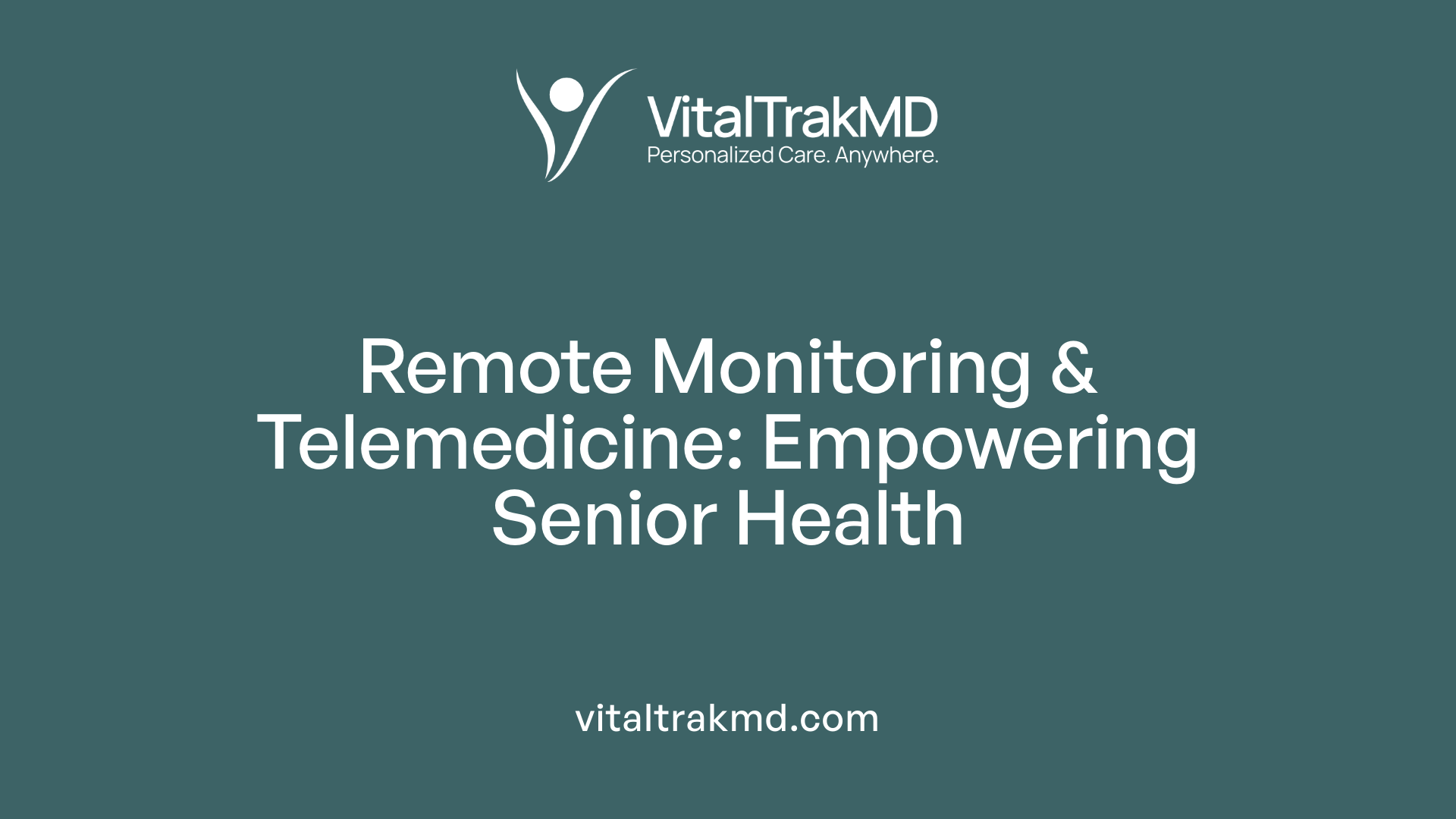How Seniors Benefit from Dual Virtual + In-Person Visits

Enhancing Senior Care with a Hybrid Model
The integration of virtual and in-person healthcare is transforming elderly care, providing seniors with a flexible, accessible, and comprehensive approach. As health systems worldwide recognize the benefits of these dual visit strategies, older adults experience improved health outcomes, greater independence, and enhanced quality of life. This article explores how combining digital and face-to-face interactions creates a resilient, patient-centered care paradigm tailored for aging populations.
Benefits of Combining Virtual and In-Person Visits for Seniors
What are the benefits of combining virtual and in-person healthcare visits for seniors?
Integrating both virtual and in-person healthcare visits offers numerous advantages for older adults. This hybrid approach significantly improves access to care, especially for seniors living in remote or underserved regions. It helps overcome transportation challenges, ensuring that seniors can receive timely medical attention without the need for long travel or waiting times.
This model supports better management of complex health conditions by enabling continuous monitoring and swift intervention when needed. Virtual visits facilitate regular check-ins for chronic disease management, mental health support, and medication adherence, while in-person visits ensure physical examinations and emergency care are accessible.
Furthermore, combining these modes of care helps address healthcare workforce shortages. Telehealth allows healthcare providers to extend their reach, utilizing remote staff and monitoring tools to deliver services more efficiently. During crises like the COVID-19 pandemic, this blended strategy maintained essential health services while reducing infection risk.
Most importantly, this approach promotes health equity and patient satisfaction by making healthcare more flexible, personalized, and resource-efficient. It supports older adults in aging in place, enhances continuity of care, and helps health systems adapt to evolving needs, ensuring seniors receive comprehensive, accessible, and high-quality care.
The Role of Telehealth in Fostering Social Inclusion and Care Quality

What role does telehealth play in enhancing social inclusion, medication adherence, and overall care for seniors?
Telehealth has emerged as an essential tool in improving the lives of older adults by providing a platform for consistent social interaction, which helps combat loneliness and social isolation. Virtual visits enable seniors to maintain regular contact with healthcare providers, friends, and family without the need for travel, fostering a sense of connection and community.
In addition, telehealth enhances medication adherence and management. Through remote monitoring devices, personalized reminders, and direct communication with healthcare professionals, older adults can better follow prescribed medication routines. This ongoing oversight helps prevent health deterioration and reduces the likelihood of hospital readmissions.
Telehealth also supports comprehensive care that is sensitive to the needs and preferences of seniors. It promotes continuity of care, especially for those who wish to age in place. By increasing access to medical services and mental health support, telehealth helps maintain independence and supports early intervention for emerging health issues.
Furthermore, integrating virtual visits with in-person care allows for flexible, patient-centered treatment. Technologies such as remote health monitoring and virtual consultations ensure that older adults receive personalized, age-friendly care that emphasizes what matters most to them. Addressing technological barriers—by making interfaces user-friendly and providing support—can reduce disparities, ensuring equitable access.
Overall, telehealth plays a crucial role in elevating healthcare quality, fostering social bonds, supporting medication routines, and enabling older adults to live independently and with dignity. Its ability to facilitate timely intervention and ongoing support leads to better health outcomes and an improved overall quality of life for seniors.
Advantages of Remote Patient Monitoring and Telemedicine

How does remote patient monitoring and telemedicine benefit seniors?
Remote patient monitoring (RPM) and telemedicine offer numerous advantages that greatly enhance healthcare for older adults. These technologies provide ongoing, real-time oversight of seniors' health conditions, allowing timely detection of medical issues before they escalate. Through regular virtual communication, healthcare providers can monitor vital signs, medication adherence, and symptoms, enabling personalized care adjustments.
These tools are particularly valuable for managing chronic diseases such as diabetes, heart failure, and arthritis. They facilitate early intervention, which can prevent deterioration, hospital stays, and emergency visits. For seniors with mobility challenges or those living in remote areas, telehealth reduces the need for travel, making healthcare more accessible and less stressful.
Moreover, telemedicine supports mental health by providing virtual counseling and social interaction, which can combat loneliness and depression. Preventive care, including routine check-ups and health education, is also strengthened through virtual visits, promoting overall well-being.
While challenges exist—like device costs and security issues—the benefits include increased safety, convenience, improved health outcomes, and higher patient satisfaction. These technologies empower seniors to maintain independence and improve quality of life, making healthcare more proactive and patient-centered.
Impact of Hybrid Care Models on Elderly Outcomes

How does a hybrid care model impact elderly care outcomes?
A hybrid care approach that combines both virtual and in-person services offers substantial benefits for older adults. It ensures continuous, personalized care by leveraging telemedicine for routine monitoring and specialist consultations while maintaining vital in-person visits for physical assessments and emergencies.
This model enables proactive management of frailty and chronic conditions. Regular remote monitoring and virtual check-ups support early detection of health deterioration, allowing for timely intervention. Such ongoing oversight helps in reducing frailty levels, improving mobility, and can even reverse certain aspects of frailty, significantly enhancing seniors’ quality of life.
Research indicates that these combined methods expand healthcare capacity, especially critical during health crises like the COVID-19 pandemic, when in-person visits may be limited. Patients report high satisfaction levels due to convenience, safety, and personalized care.
The use of digital tools based on behavioral theories, such as self-efficacy and social interdependence, fosters patient engagement and adherence to treatment plans. Overall, hybrid models foster better health outcomes, increase safety, and create a resilient system capable of serving the complex needs of older adults effectively.
In summary, the integration of telehealth with traditional care optimizes elderly care by improving functional status, reversing frailty, reducing hospitalizations, and offering a safer, more accessible healthcare experience for seniors.
Evidence Supporting the Effectiveness of Integrated Care Approaches
What evidence exists to support the effectiveness of integrated virtual and in-person senior care?
Numerous studies and trials highlight the benefits of combining virtual and in-person care for older adults, especially those with complex health needs. Research demonstrates that hybrid models improve health outcomes, such as reducing frailty and enhancing physical function.
One notable example is a 15-month community-based trial involving older adults and their caregivers. This study focused on a hybrid care approach that emphasized self-care, social interdependence, and tailored interventions. Results revealed a notable decrease in frailty levels among participants, with some reversing deterioration observed in control groups receiving standard care.
Advanced technological tools also support this integrated approach. Platforms like tele-rehabilitation and immersive virtual platforms enable remote assessments and ongoing health monitoring. These tools help seniors maintain independence, reduce hospital readmissions, and manage chronic conditions more effectively.
The widespread adoption of such combined models showcases their effectiveness in overcoming barriers like limited mobility or access to care. They promote aging-in-place strategies, thus helping to sustain healthcare systems by reducing pressure on emergency services and hospitals.
Patient satisfaction remains high, with many seniors appreciating the convenience and personalized care that hybrid models provide. Caregivers also report better management of their loved ones’ health, feeling more involved and supported.
Overall, the integration of in-person and virtual care fosters more sustainable healthcare by optimizing resources and ensuring continuous, patient-centered support for older adults.
Implementing Dual Care Strategies Effectively
How can healthcare providers effectively implement virtual and in-person care strategies for seniors?
Successfully combining virtual and in-person healthcare options requires a flexible, personalized approach tailored to each older adult's unique health needs and preferences. Providers should develop integrated models, often called hybrid care pathways, which blend hospital-based services with community or home-based care.
Utilizing digital health technologies such as telemedicine platforms, remote health monitoring devices, and comprehensive electronic health records helps ensure continuous management of chronic conditions. These tools enable proactive and personalized care, allowing healthcare professionals to monitor health status remotely, provide medication guidance, and detect early signs of deterioration.
Education plays a vital role. Assisting seniors in navigating new technologies and addressing digital literacy challenges helps improve their comfort and engagement with virtual care systems. Customizing solutions based on individual capabilities, such as offering audio-only options for those with hearing or eyesight issues, supports greater accessibility.
A focus on value-based care emphasizes efficiency and quality—prioritizing health outcomes while controlling costs. Establishing multidisciplinary teams, including nurses, social workers, and caregivers, enhances personalized care, fostering trust and satisfaction.
Designing adaptable environments — both physically and digitally — along with flexible scheduling, ensures that each patient’s preferences are met. This approach not only improves health outcomes but also respects the social and emotional needs of older adults, supporting aging in place and maintaining independence.
In summary, effective implementation hinges on tailored, technology-enabled, and adaptable strategies that prioritize patient engagement, caregiver involvement, and seamless integration of care settings.
Strategies to Implement Dual Healthcare Visits for Older Adults

What strategies can be used to implement dual healthcare visit approaches for older adults?
To effectively support older adults through both virtual and in-person care, healthcare systems need to adopt targeted strategies that address their unique needs and preferences.
One of the primary strategies is designing flexible scheduling systems. These systems can accommodate the varying clinical and personal requirements of seniors, allowing them to choose between virtual and face-to-face visits based on their health status, comfort, and availability.
In addition, employing user-friendly telemedicine technologies is crucial. Devices and platforms should be intuitive, with clear instructions and accessible support. Providing training sessions and technical assistance ensures older adults and their caregivers can confidently navigate telehealth services.
Personalized care plans that incorporate both modes of care are essential. Tailoring these plans to individual circumstances enable smooth transitions between virtual and in-person visits, ensuring continuity and appropriate clinical assessment. For example, chronic disease management might be supported via remote monitoring and regular virtual check-ins, supplemented by periodic in-person evaluations.
Effective care coordination is facilitated through the integration of electronic health records (EHRs) and digital platforms. These systems ensure that information from both care modes is seamlessly shared among providers, reducing redundancy and improving decision-making.
Caregiver assistance also plays a vital role. Training caregivers to help set up technology, troubleshoot issues, and participate in virtual visits can improve care experiences. On-demand support and clear instructional materials further empower caregivers and older adults.
Case studies from international health centers demonstrate that hybrid models, such as remote monitoring combined with in-person assessments, can effectively expand healthcare capacity. These models help reduce hospital-acquired infections, address disparities, and support those in remote or underserved areas.
In summary, implementing dual care approaches involves a combination of flexible scheduling, accessible technology, personalized planning, integrated data systems, and caregiver involvement. Together, these strategies foster a patient-centered, efficient, and adaptable healthcare environment for older adults.
Overcoming Barriers in Telehealth Access for Seniors

What are the challenges faced by seniors in accessing telehealth services?
Seniors often encounter several obstacles when trying to use telehealth services. A primary issue is physical and sensory impairments, such as hearing loss, vision problems, or cognitive difficulties, which can make it hard to navigate digital platforms or communicate effectively.
Low digital literacy is another significant barrier. Many older adults are unfamiliar with smartphones, computers, or videoconferencing tools, leading to frustration or resistance to adopting new technologies.
Access to necessary devices and stable internet connections remains uneven, especially among low-income and rural populations. Without reliable internet or the right devices, telehealth becomes difficult or impossible.
Language barriers and lower literacy levels can further complicate the situation, making it hard for seniors to understand instructions or engage fully during virtual visits. Additionally, some older adults feel uncomfortable sharing sensitive health information over digital platforms due to privacy concerns or trust issues.
Caregiver involvement plays a critical role. Many seniors rely on family members or caregivers for help with setting up devices, managing platforms, or ensuring connectivity. Lack of caregiver support can limit telehealth use among the homebound or those with complex health needs.
Finally, fears of inadequate physical examination and difficulty establishing a personal connection through screens can decrease confidence and willingness to use telehealth services.
Addressing these challenges involves designing user-friendly technologies tailored for seniors, providing targeted education and support, improving infrastructure, and encouraging caregiver participation. By tackling these barriers, healthcare providers can make telehealth more accessible, improving health outcomes and satisfaction for older populations.
Policy Implications and Future Directions for Elderly Healthcare
What are the policy implications and recommendations for adopting dual care approaches in elderly healthcare?
The shift toward blended models combining virtual and in-person care for older adults necessitates comprehensive policy support. Establishing supportive reimbursement policies is essential. This includes expanding billing codes to cover telehealth services and ensuring sustainable funding models that encourage providers to use hybrid approaches.
Infrastructure development is another critical component. Ensuring widespread high-speed internet, especially in rural and underserved areas, is vital for equitable access. Policymakers should prioritize investments in digital infrastructure to bridge the digital divide among older populations.
Culturally sensitive program design is necessary for successful implementation. Policies must promote community-specific adaptations, involving key stakeholders such as healthcare providers, patients, families, and Indigenous communities. These efforts ensure programs are acceptable, accessible, and tailored to diverse needs.
Workforce training and fostering interdisciplinary collaboration are crucial. Policymakers should support ongoing education that equips healthcare workers with skills in telehealth technology, cultural competence, and team-based care. Addressing resistance and ensuring workforce sustainability will facilitate the wider adoption of hybrid models.
Leveraging technology for improved care coordination and equity is also paramount. Innovations like remote monitoring devices and user-friendly platforms can enhance patient engagement, reduce costs, and prevent health deterioration. Policies must also safeguard privacy, data security, and address social determinants impacting healthcare access.
Collectively, these policy directions aim to embed flexible, equitable, and sustainable dual care strategies into the healthcare framework, optimizing outcomes for older adults and supporting the shift toward more accessible, patient-centered care.
Shaping the Future of Elderly Healthcare
Integrating virtual and in-person healthcare visits offers a resilient, patient-centered approach that aligns with evolving needs and technological advancements. As evidence mounts in favor of hybrid models, health systems are encouraged to adopt flexible, accessible, and equitable strategies that improve care quality, reduce costs, and support aging populations. Policymakers, providers, and communities must work collaboratively to overcome barriers and harness innovations, ensuring a future where seniors receive safe, satisfying, and effective healthcare regardless of location or condition.
References
- Virtual Visits in Home Health Care for Older Adults - PMC
- Perceptions and Uses of Telehealth in the Care of Older Adults - PMC
- The Benefits of Telemedicine for Older Adults - Trualta
- Senior patients happy with telehealth and want it as care option
- [PDF] Older Adults' Experience With Virtual Care Two Years Into The ...
- 5 Benefits of Telehealth for Seniors - One Medical
- The Use of Telemedicine in Older-Adults During the COVID-19 ...
- Barriers to Telemedicine Video Visits for Older Adults ... - JMIR Aging
- Telehealth Is Just as Effective as In-person Care, Study Finds
Recent articles
Want to Feel Better and Live Healthier?
Join hundreds of patients taking control of their health with personalized care that fits their life – not the other way around.
Rated 4.8/5 by 32+ customers







